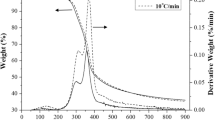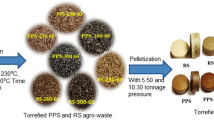Abstract
Torrefaction is thermo-chemical process which can improve solid fuel quality as well as grindability. In previous studies, torrefaction has been studied mainly for removal of moisture and for improving grindability. In this experiment, the characteristics of torrefied waste sawdust were studied especially for its energy yield. Hence, torrefaction was performed on varying reaction temperatures (200, 220, 240, 260, 280, 300 °C) and solid residence time (10, 30, 60 min). The results indicated that the yield of torrefaction decreases with increasing temperature and residence time. It was found that above 280 °C, the yield got remarkably decreased. The lowest yield was obtained at the residence time of 60 min. It was also noticed that the HHV of torrefied samples increases with increasing temperature. The highest HHV was found to be 26.09 MJ/kg which was obtained at 60 min and 300 °C. However, the highest energy yield was obtained to be 104.17 % which was noticed at 30 min and 260 °C.













Similar content being viewed by others
References
Prins MJ, Ptasinski KJ, Frans JJG (2006) Torrefaction of wood. Part 1. Weight loss kinetics. J Anal Appl Pyrol 77:28–34. doi:10.1016/j.jaap.2006.01.002
Arias B, Pevida C, Fermoso J, Plaza MG, Rubiera F, Pis JJ (2008) Influence of torrefaction on the grindability and reactivity of woody biomass. Fuel Process Technol 89:169–175. doi:10.1016/j.fuproc.2007.09.002
Chen WH, Kuo PC (2011) Torrefaction and co-torrefaction characterization of hemicellulose, cellulose and lignin as well as torrefaction of some basic constituents in biomass. Energy 36:803–811. doi:10.1016/j.energy.2010.12.036
Phanphanich M, Mani S (2011) Impact of torrefaction on the grindability and fuel characteristics of forest biomass. Bioresour Technol 102:1246–1253. doi:10.1016/j.biortech.2010.08.028
Oasmaa A, Elliott DC, Müller S (2009) Quality control in fast pyrolysis bio-oil production and use. Environ Prog Sustain Energy 28:404–409
Di Blasi C (2008) Modeling chemical and physical processes of wood and biomass pyrolysis. Prog Energy Combust Sci 34:47–90. doi:10.1016/j.pecs.2006.12.001
Bridgeman TG, Jones JM, Shield I, Williams PT (2008) Torrefaction of reed canary grass, wheat straw and willow to enhance solid fuel qualities and combustion properties. Fuel 87:844–856. doi:10.1016/j.fuel.2007.05.041
Deng J, Wang GJ, Kuang JH, Zhang YL, Luo YH (2009) Pretreatment of agricultural residues for co-gasification via torrefaction. J Anal Appl Pyrol 86:331–337. doi:10.1016/j.jaap.2009.08.006
Wilk M, Magdziarz A, Kalemba I, Gara P (2016) Carbonisation of wood residue into charcoal during low temperature process. Renew Energy 85:507–513. doi:10.1016/j.renene.2015.06.072
Wilk M, Magdziarz A, Kalemba I (2015) Characterisation of renewable fuels’ torrefaction process with different instrumental techniques. Energy. doi:10.1016/j.energy.2015.04.073
Zheng A, Zhao Z, Chang S, Huang Z, Wang X, He F, Li H (2013) Effect of torrefaction on structure and fast pyrolysis behavior of corncobs. Bioresour Technol 128:370–377. doi:10.1016/j.biortech.2012.10.067
Di Blasi C, Lanzetta M (1997) Intrinsic kinetics of isothermal xylan degradation in inert atmosphere. J Anal Appl Pyrol 40:287–303. doi:10.1016/S0165-2370(97)00028-4
Meng J, Park J, Tilotta D, Park S (2012) The effect of torrefaction on the chemistry of fast-pyrolysis bio-oil. Bioresour Technol 111:439–446. doi:10.1016/j.biortech.2012.01.159
Prins MJ, Ptasinski KJ, Janssen FJJG (2006) More efficient biomass gasification via torrefaction. Energy 31:3458–3470. doi:10.1016/j.energy.2006.03.008
Hakkou M, Pétrissans M, Gérardin P, Zoulalian A (2006) Investigations of the reasons for fungal durability of heat-treated beech wood. Polym Degrad Stab 91:393–397. doi:10.1016/j.polymdegradstab.2005.04.042
Chen WH, Hsu HC, Lu KM, Lee WJ, Lin TC (2011) Thermal pretreatment of wood (Lauan) block by torrefaction and its influence on the properties of the biomass. Energy 36:3012–3021. doi:10.1016/j.energy.2011.02.045
Nunes LJR, Matias JCO, Catalão JPS (2014) A review on torrefied biomass pellets as a sustainable alternative to coal in power generation. Renew Sustain Energy Rev 40:153–160. doi:10.1016/j.rser.2014.07.181
Bergman PCA (2005). Combined torrefaction and pelletisation. The TOP process. https://www.ecn.nl/docs/library/report/2005/c05073.pdf. Accessed July 2005
Bridgeman TG, Jones JM, Williams A, Waldron DJ (2010) An investigation of the grindability of two torrefied energy crops. Fuel 89:3911–3918. doi:10.1016/j.fuel.2010.06.043
Chen WH, Kuo PC (2010) A study on torrefaction of various biomass materials and its impact on lignocellulosic structure simulated by a thermogravimetry. Energy 35:2580–2586. doi:10.1016/j.energy.2010.02.054
Boateng AA, Mullen CA (2013) Fast pyrolysis of biomass thermally pretreated by torrefaction. J Anal Appl Pyrol 100:95–102. doi:10.1016/j.jaap.2012.12.002
Park WC, Atreya A, Baum HR (2010) Experimental and theoretical investigation of heat and mass transfer processes during wood pyrolysis. Combust Flame 157:481–494. doi:10.1016/j.combustflame.2009.10.006
Felfli FF, Luengo CA, Suárez JA, Beatón PA (2005) Wood briquette torrefaction. Energy Sustain Dev 9:19–22. doi:10.1016/S0973-0826(08)60519-0
Khumsak O, Wattananoi W, Worasuwannarak N (2011) Bio-oil production from the torrefied biomass. 2011 IEEE 1st conference on clean energy and technology, CET 2011: 68–71. doi:10.1109/CET.2011.6041438
Uemura Y, Omar WN, Tsutsui T, Yusup SB (2011) Torrefaction of oil palm wastes. Fuel 90:2585–2591. doi:10.1016/j.fuel.2011.03.021
Couhert C, Salvador S, Commandré JM (2009) Impact of torrefaction on syngas production from wood. Fuel 88:2286–2290. doi:10.1016/j.fuel.2009.05.003
Prins MJ, Ptasinski KJ, Janssen FJJG (2006) Torrefaction of wood. Part 2. Analysis of products. J Anal Appl Pyrol 77:35–40. doi:10.1016/j.jaap.2006.01.001
Na BI, Ahn BJ, Cho ST, Lee JW (2013) Optimal condition of torrefaction for the high-density solid fuel of Larch (Larix kaempferi). Korean Chem Eng Res 51:739–744. doi:10.9713/kcer.2013.51.6.739
Acknowledgments
This work is financially supported by Korea Ministry of Environment (MOE) as Waste to energy recycling Human resource development Project.
Author information
Authors and Affiliations
Corresponding author
Rights and permissions
About this article
Cite this article
Yoo, H.S., Choi, H.S. A study on torrefaction characteristics of waste sawdust in an auger type pyrolyzer. J Mater Cycles Waste Manag 18, 460–468 (2016). https://doi.org/10.1007/s10163-016-0482-3
Received:
Accepted:
Published:
Issue Date:
DOI: https://doi.org/10.1007/s10163-016-0482-3




